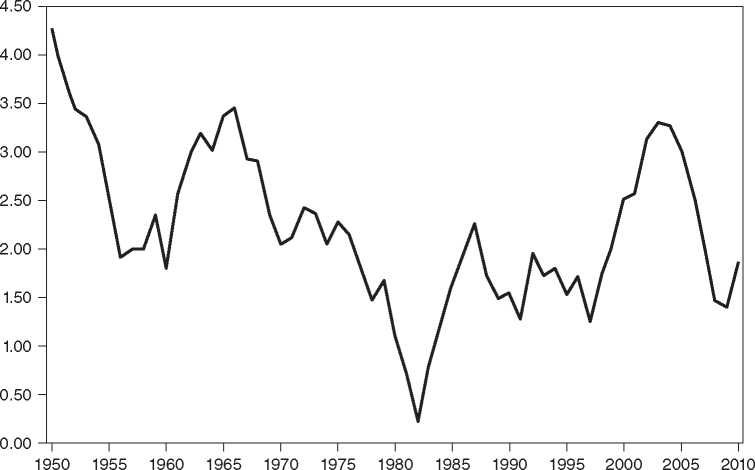The wave of new products that hit the market after World War II was accompanied by rapid productivity growth. Indeed, growth was so rapid that some observers began to talk about a “third Industrial Revolution.” After 1970, however, productivity growth slowed (as illustrated in Figure 29.1). Figure 29.1 plots the growth of output per labor hour in the nonfarm business sector by showing the average annual percentage change for the previous five years. (The previous five years are used, rather than just the most recent year, to clarify the longer-term trends.) The exact date when the slowdown began (or the years of transition) are a matter of debate—you can make your own judgment as you look at the diagram—but the contrast between the early years of the postwar era and the middle years is dramatic. The slowdown in productivity growth was a major concern of policymakers because in a market economy, productivity is one of the fundamental determinants of real wages, a theme we will return to later.
Why did productivity growth slow in the 1970s? A number of factors were at work. First, the shift of production from manufacturing to the service sector was important. Productivity growth is usually harder to achieve in services than in other sectors. Quality improvements, moreover, are extremely difficult to measure in the service sector, so output growth may have been understated. Second, as Michael Darby (1984) argued, changes in the structure of the labor force accounted for much of the slowdown. Many young and, therefore, inexperienced workers were entering the labor force for the first time in the 1970s, a result of the earlier “baby boom.” Third, the growth of capital per unit of labor input also slowed in the 1970s. To some extent, this was the result of rising inflation that disrupted financial markets and discouraged saving. Fourth, the highly variable rate of inflation in the 1970s may have distorted price signals and prevented the allocation of resources to their most efficient uses. Fifth, some blame probably attaches to the high cost of complying with new government regulations stemming from legislation passed in the 1960s and 1970s. Sixth, when oil prices rose sharply, industries and
FIGURE 29.1 The
Growth of Output per Hour in the Nonfarm Business Sector: Percent Change per Year for the Previous Five Years, 1950-2010.

Note: The growth of labor productivity slowed dramatically in the 1970s, and then rose dramatically in the early 2000s.
Source: Historical Statistics of the United States Colonial Times to 1970-1975, Series D-684; and Economic Report of the President, 2012, Table B-49.
Agricultural producers that had relied on cheap and abundant oil suddenly were forced to adjust to higher prices. Large investments were required to replace older equipment with more energy-efficient equipment, even when the new equipment produced the same output per labor hour. At the turn of the century, productivity growth began to rise, as is evident in Figure 29.1. Adjustment to higher energy prices, the computer revolution including the Internet, and corporate restructuring all contributed to a rise in productivity growth that was as unexpected as was the preceding decline.




 World History
World History









